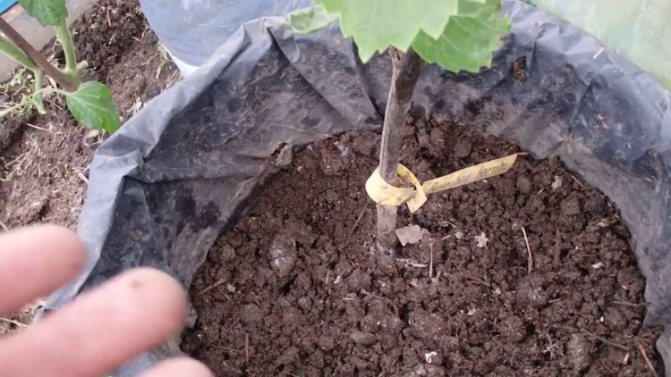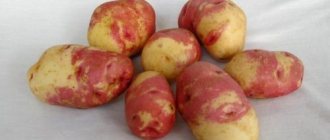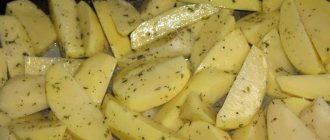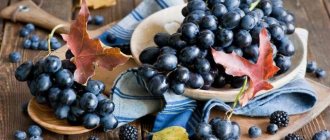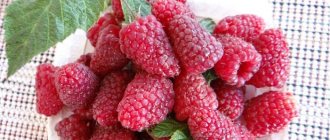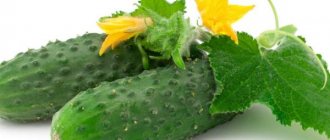Among the table varieties of grapes widely cultivated in summer cottages and household plots, interspecific hybrids obtained on the basis of Amur when crossing with European varieties are very popular. Among them is the domestic grape variety "Delight". Along with other hybrid forms, it is distinguished by high productivity, resistance to diseases and pests, and early ripening of shoots. Due to their increased frost resistance, such plants are widely used in the arbor non-sheltering culture.
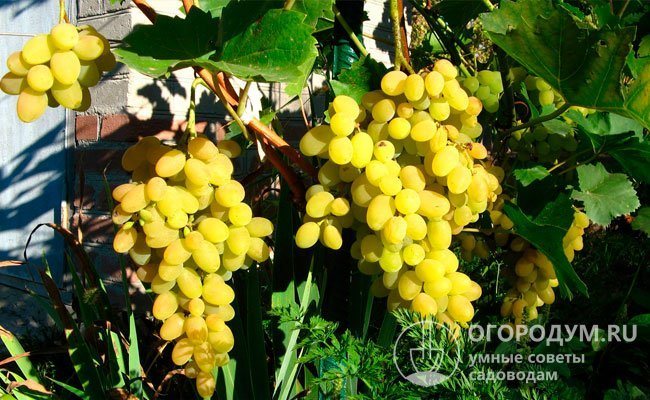
"Delight" (pictured) gardeners successfully grow both in the zone of industrial viticulture in Russia, and in the Moscow region, southern regions of the Urals and Siberia
Despite the obvious advantages, this grape culture is currently not included in the group of the best market varieties, since there are varieties with similar ripening periods, but with a higher marketability of fruits. However, many amateur winegrowers grow "Delight" "for themselves." It remains the most common on amateur sites in various regions of our country and neighboring countries.
We suggest that you familiarize yourself with the brief characteristics of the variety given in the table:
| Parameter | Characteristic |
| Culture | Grapes (Vitis Vinifera L.) |
| Variety | "Delight" ("Delight white", 8-404-925) |
| Growing conditions | Gardening |
| Direction of use | Dining room |
| Flower type | Bisexual |
| Growth strength of bushes | Big |
| Ripening terms | Early ripe (very early): the first decade of August (110-120 days from the start of the growing season). Consumer maturity August 8-10 |
| Period of consumption (shelf life of fruits) | Summer (autumn); in the refrigerator for about 4 months |
| Early maturity | 4th year |
| Productivity of one bush per season | High - on average 10 kg (maximum up to 25-30 kg); in industrial plantings - about 12 t / ha |
| The shape and weight of the bunch | Very large, conical, sometimes with a wing, more often shapeless, of medium density; weighing 500-600 g, maximum - over 1 kg |
| Fruit shape and color | Large, slightly oval, sometimes rounded, white, sunburned. Firmly attached to the stem. The skin is dense, it is not felt when eating; with a gray thin layer of wax coating (pruin) |
| Fruit weight | 5-6 g |
| Pulp | Fleshy, juicy, dense, crispy |
| Tasting assessment (taste) | 8.2-8.4 points (out of 10) - the taste is sweet, simple, pleasant |
| Purpose of fruits | Dessert type |
| Disease resistance | Weakly affected by mildew - 2-2.5 points (out of 5); susceptible to powdery mildew - 3-3.5 points (out of 5) and phylloxera; highly resistant to gray mold |
| Winter hardiness | Withstands frosts down to -25 ℃ (in the natural conditions of the Rostov region does not require shelter for the winter) |
| Year of registration in the State Register of the Russian Federation | 1992 |
| Recommended growing regions | North Caucasian (6), Nizhnevolzhsky (8) |
| Originator | Federal State Budgetary Scientific Institution "Federal Rostov Agrarian Research Center" (Rostov Region) |
Description and characteristics of the variety
The Delight grape is described as medium to vigorous. The trunk is thick, the leaves are light green with notches. The flowers are self-pollinated. The bunches are large, conical or shapeless, the weight of the bunch is from one and a half to two kilograms. Large oval-shaped berries weigh about 6 g each, the color of the fruit is yellowish-white, with a tan, inside there are two or three seeds.The peel of the berries is quite dense, the taste of the pulp is harmonious, the sugar content is from 19% to 26%, and the acid content is 5-9 g per liter. The rooting rate of cuttings is normal, the load on one bush ranges from 35 to 45 eyes. Ripe grapes can be on the vine for a month, while practically not losing their taste. The variety is resistant to frost down to - 25 ° С and is not susceptible to diseases, transportable. With poor pollination, the berries can become smaller.
Features of the variety


Delight red is a hybrid of grapes, which was obtained in Russia by crossing two popular varieties - Delight and Original. This variety is also known under other names, such as ZOS-1 or Zosya.
The grape bushes are considered to be medium-sized, the vine ripens very well and reaches almost the entire length of the shoot. The flowers of the plant are considered functionally feminine, they are well and stably pollinated if they are located next to bisexual grape varieties that bloom at the same time.
Varieties
The following varieties of these grapes have been bred by crossing Rapture with certain varieties.
Delight oval or Baklanovsky
Obtained by crossing with the Original variety. Grape bushes Delight Oval, medium-sized, with bisexual flowers. Ripening period 115-125 days. The brushes are large, weighing about 650 g. The berries are white, may have a golden tan, they ripen oval in August, the pulp is juicy with a harmonious taste, the sugar content is 18-23%. The variety is winter-hardy, resistant to mildew, oidium, gray rot.
Delight red
Early maturing, medium or vigorous variety, vigorous vine, bright green leaves. The flowers are functionally feminine, the clusters are loose, conical, weighing 600-800 g. The berries are large, oblong, ovoid, pink or light red, the flesh is tender, sweet, with strawberry notes. Transfers temperatures down to -25 ° C. Not resistant to powdery mildew and phylloxera.
Nutmeg delight
Table hybrid white grape variety. The bushes are medium-sized, the load is about 25 eyes, the variety is high-yielding and early maturing, the berries ripen in 105-110 days. The bunches are large, dense, weighing about the same as that of the Red's Delight. The berries are white, with an amber tint, have an oval shape, weigh about 6 g. The taste is harmonious with a hint of nutmeg, sugar is 25%. This grape is transportable and tolerates frosts down to - 26 ° С. Not resistant to powdery mildew and phylloxera.
Delight is perfect
A hybrid of Villars Blanc and Delight. Vigorous, large clusters, about 1 kg in weight, conical in shape, may have a wing. The berries are oval, light green in color, about 2 cm in size, the flesh is juicy with a harmonious taste with floral notes, sugar content is from 16 to 19%, ripens in 120-125 days. Possesses good transportability and keeping quality. May be susceptible to mildew.
Delight is black
In another way, he is called the Black Baron, Brother of Rapture. Vigorous bush, good rooting. The flowers are functionally feminine. The fruits ripen in 115-125 days. Bunches weigh up to 750 g, sometimes up to 2000 g, cylindrical conical shape. The berries are oval, blue in color, the taste is simple, the sugar is 17.5%. Frost resistance up to -25 ° С. Resistant to powdery mildew, mildew, may be susceptible to gray rot. For pollination, there must be varieties with bisexual flowers nearby.
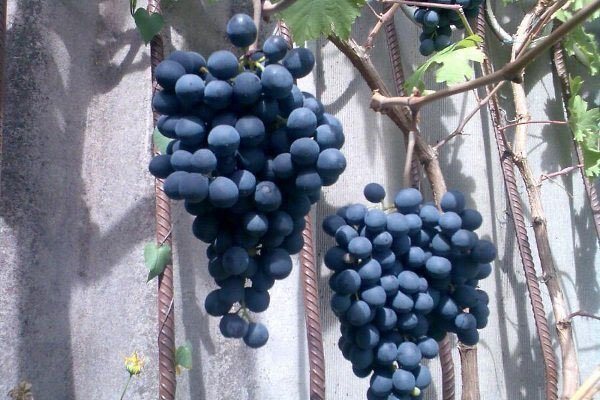

This is what Black Rapture grapes look like.
History of origin and contribution of "Rapture" to breeding
This hybrid variety was bred in the early 80s of the last century by breeders of the All-Russian Research Institute of Viticulture and Winemaking named after V.I. Ya. I. Potapenko ”by crossing the hybrid form 2-5-92-7-2 (“ Dawn of the North ”ד Dolores ”) and the variety“ Russian Early ”.
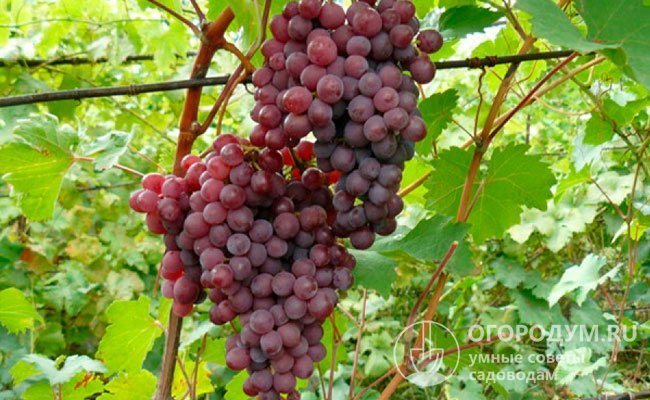

"Russian early" (pictured) - one of the cultivars, which served as a "mother" form
Since 1983, state variety trials of the plant began in experimental plantations of the USSR.In 1992, "Delight" was officially registered in the State Register of the Russian Federation as zoned in two regions - the North Caucasus and Nizhnevolzhsky. Winter hardiness and wonderful taste of the fruits made these grapes in demand in industrial plantings and on personal household plots in many regions of our country, as well as in Ukraine and Moldova. At present, the possibilities of growing this type of culture are being evaluated on experimental plots in the soil and climatic conditions of the southern and central regions of Belarus.
You can learn more about the peculiarities of the variety in a video filmed by an amateur winegrower in the Nizhny Novgorod region:
The variety has earned great recognition from breeders who actively used it as a donor of such valuable qualities as large-fruited, early maturity and high yield. Specialists of VNIIViV them. Ya. I. Potapenko brought out a whole line of new hybrid forms: "Black Delight", "Red Delight", "Muscat Delight", "Improved Delight" ("Kesha") and others. For all descendants, the name of the original variety in their name is characteristic, and the hybrids differ from each other only in the size, color and taste of the berries.


"Black Delight" (in the photo on the left) and "Red Delight" (on the right) are new hybrid varieties created by domestic breeders on the experimental plots of VNIIViV
You can learn more about these hybrid varieties in the following videos:
Planting and leaving
Caring for this unpretentious variety is easy. Delight grapes are recommended to be grown from the south or southwest side. There should be plenty of light, it is also necessary to ensure the absence of drafts and stagnation of cold air. It will grow well on fertile loose soils, chernozems.
Advertisement 1
You can plant grapes in spring and autumn. The advantage of planting in spring is that the seedling will develop well the root system over the summer.
You can plant green or lignified seedlings. Landing pits are prepared for them, usually 80 cm deep and of the same diameter. The landing process takes place according to the following algorithm:
- Drainage is poured into the pit; gravel, crushed stone, pebbles are suitable for this.
- A nutrient mixture of earth with humus is laid out on top of the drainage.
- Wood ash is poured - 3 liters and superphosphate - 0.3 kg.
- A mixture of earth and sand in equal parts is placed on top, a mound is formed from it.
- Let the planting pit settle for several weeks.
- The seedling, before being placed in the hole, is dipped in a clay chatterbox.
- They put it on a mound, spread the roots, sprinkle it with earth and trample it down.
- Water 10-15 liters of settled water.
- They cover it with earth to the edges of the sedimentary pit, tamp it down and water it again.
- The soil under the bush is loosened and mulched.
Growing rules
Although the varieties of this variety have some differences, it is necessary to grow and care for plants of different types in the same way. Since this grape is unpretentious, it does not require special attention.
All a winegrower needs to do is follow these simple rules:
- Landing. The Delight grape variety is propagated by seedlings. Young plants should be planted either in the fall or in the spring. For planting, areas well-lit by the sun, protected from the wind, are chosen. If the sun is not enough for the vine, you even need to pick off the leaves that create shade, otherwise the berries will not ripen. The soil should be well fertilized, it is better to use mineral complexes. Ideal for Delight black soil or light loam. Saplings are planted at a fairly large distance from each other and from other plants in the garden - with an interval of at least 4 meters. A seedling hole is dug deep - about 80 cm. An arch is needed for the proper formation of the vine.
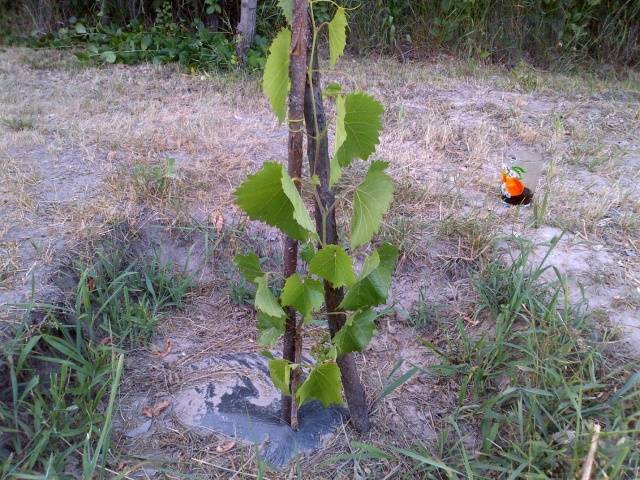

- Pruning grapes. Like all table varieties, Rapture is trimmed short.Optimally - leave 4 eyes on the shoots (taking into account the lowest eye on the vine). It is recommended to prune the bushes in the spring.
- Watering and fertilizing. After planting the seedlings, several buckets of water should be poured under each of them. Subsequently, you will not have to water the bush, because it tolerates even severe drought perfectly. You can feed the vine through the drainage, for this I use mineral supplements during the formation of bunches. Although Rapture is able to withstand most diseases, grapes are susceptible to phylloxera contamination. Therefore, the bushes should be treated with fungicidal preparations twice a year.
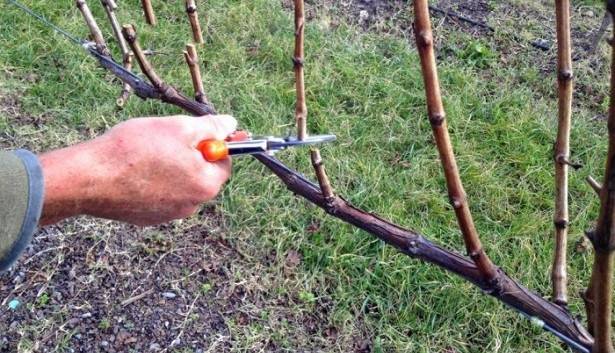



Additional pollination
Variety Delight has bisexual self-pollinated flowers, they are distinguished by long stamens with anthers at the ends and a pistil slightly lower than the stamens. The pollination process takes place mainly through the wind. For the best effect, several different self-pollinated varieties should be nearby.
To get the desired harvest, some growers practice additional pollination. This is done for the first time in a season when half of the flowers in the inflorescences are fully blooming. The procedure is carried out in the morning, as the dew dries up, you need to finish it before noon. But if the sky is overcast, and precipitation is not expected to pollinate the grapes, it is permissible throughout the day.
They do it this way:
- Shake off the pollen into a clean, dry jar.
- They take a piece of skin with rabbit fur and use it to transfer pollen to the flowers.
For convenience, the fur is attached to a wooden spatula, after which it has been well disinfected. It is important to carry out the procedure with care, avoiding damage to the buds.
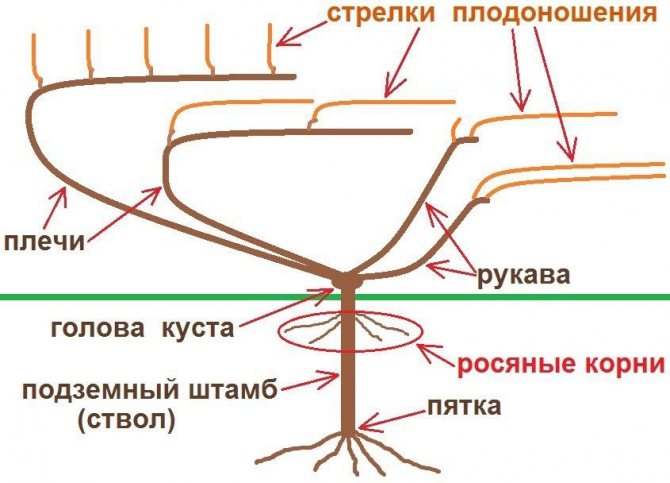

Grape bush scheme
Features of planting for scion
The description refers to the green-to-green option as the most effective.
Preparing cuttings
Cuttings ready for planting should not be dry, have a green cut and 2-3 eyes. On the side that will be inserted into the split of the rootstock, it must be cut from both sides at an angle, forming a flat point. These are the places with which the black will fit snugly against the donor's wood.


This edge should be kept for at least a day in water or a solution of "Humate", which stimulates the growth of the root system. Instead of "Humate" before grafting, you can sprinkle slices with "Kornevin", this will also speed up the process.
To protect the cuttings from drying out during the survival period, experienced growers advise to lower the upper part in melted paraffin, "paraffin".
Stock preparation
Includes stages:
- Cutting off old vines (about 10 cm stump should remain).
- Cleaning the cut.
- Splitting the hemp. The depth of the split should correspond to the trimmed part of the cutting, no more, otherwise additional difficulties may arise.
If the width of the stem allows two or more splits in it, this is acceptable. It is only important to avoid thickening in the future.
The sharp end of the cutting should be inserted into the split, clamped as tightly as possible, fix and coat the junction with wet clay. A support is immediately dug in next to it. It remains to make abundant watering and mulch the tree trunk circle.


Pruning and shaping
Delight, a vigorous grape variety, without proper control, can be overwhelmed by the harvest. To avoid this, grapes are pruned from the very first year. In order for the grapes to bear fruit well, it is necessary to stimulate the growth of perennial wood. A grape bush is formed in the spring, before the sap flow begins.
They do it as follows:
- For forming on a trunk in the first year, two powerful shoots are left on the sleeve, the rest are cut off.
- In the second year, the leading shoot is cut to three eyes, the next most powerful shoot is shortened, leaving two eyes. During the summer, stepchildren are removed, closer to September they pinch the main shoot, before that they tied it to a support.
- In the third year, in the spring, the stem is cut to the desired height. And also remove the shoots, leaving only two of the upper buds, they are pruned, leaving two eyes and tied to the support.
- In the fourth year, new shoots grow on the sleeves, you need to remove all the lower stepsons and keep a distance of about 20 cm between the upper ones.
- In the fifth year, the shoots left are cut off, leaving three eyes.
From the sixth year onwards, it remains only to maintain the shape of the bush.
Advertisement 3
In the summer, sanitary pruning is carried out, removing diseased, dried and thickening branches.
Growing the Vostorg variety on a trunk is suitable for the southern regions and the middle lane. In the northern regions, a standard-free fan formation is used so that it is convenient to cover the grapes for the winter.
Important! When pruning last year's vine, so that tissue dying off does not begin, leave a stump of at least 2 cm.
Winegrowers' comments on the Courage grape
The shape is interesting for its size and beautiful shape of the berry: conical, elongated, a pink barrel turns out in the sun, it will look pretty nice (Vladimir Shpak, Ukraine)
The form is very promising, I think. Compared to Dubovsky pink, this form is much better for me, the pollination is excellent, not like that of Dubovsky it crumbles. Disease resistance is an order of magnitude higher than that of Dubovsky, and the berry will not be inferior to Dubovsky, with good care of the berry 15-20 grams, or even more. Dubovsky is gaining more color, so there is more vinmania to him. (Alexander Burdak, Ukraine)
Grape Pests Delight
The Delight grape is resistant to powdery mildew and rot, but is not immune to the attacks of phylloxera. This small insect can enter the area with infected planting material. Therefore, all seedlings must be purchased in reliable proven places and carefully inspected before buying. Bulges on the roots or leaves indicate phylloxera infection of the grape.
Phyloxera or grape aphid affects the shoots, leaves, inflorescences, roots of the plant. The pest looks like a small yellowish-green insect. And signs of damage to grapes are characteristic growths - galls. More often, aphids infect old plants, spread through dirty pruning shears, diseased seedlings, as well as with the help of rain, wind, birds.
They get rid of phylloxera by spraying the vineyard with insecticides, or if the pest is still a little folk methods. For example, dusting with wood ash, tobacco dust.
The bunchy leafworm is another grape pest. It is a small butterfly with triangular wings of light brown color with dark spots. Caterpillars are green, eat buds in huge quantities, entangle the vine with a cobweb, when the grapes have faded, the larvae pupate. After 10 days, a new generation of butterflies emerges from the pupae, which also lay eggs. The hatched larvae feed on green berries. As a result, the berries shrink and can be affected by a fungus. The pest can move to the vineyard from fruit trees, conifers.
They fight the leafworm with biological and chemical insecticides. Processing is carried out as soon as the first larvae are noticed. For prevention, the vineyard is sprayed when the buds begin to bloom.
In a rainy summer and in violation of agricultural technology, there is a risk of mildew disease. For prevention, grapes are treated with sulfur, while the ambient temperature should be at least + 20 ° C, since sulfur fumes affect the fungus.
Photo of grapes Courage


Bunch of grapes Courage. Photo by S.E. Gusev


Berries of grapes Courage (Guseva)
Berries of grapes Courage (Guseva)
Bunch of grapes Courage (Guseva)
Testimonials
Some gardeners complain that Rapture does not ripen, others are not satisfied with the sourness, but most are satisfied with the quality and taste of the berries.
Ivan: I grow Delight in the suburbs, the main thing is to shelter for the winter, and so there are no special problems. I am happy with the harvest, I thin out the brushes so as not to overload the vine, the berries are large and the branches are intact.
Tatiana: I grow several varieties, but Delight is my favorite! The whole family adores him. The bunches can hang on the branches for a long time without crumbling until the grandchildren arrive.
What species does it belong to?
Early ripening table grapes. Begins to bear fruit in the third year after planting.
Combines well with most rootstocks and varieties. It is used in winemaking as an integral element in a bouquet of high-quality dessert wines, as well as in juices, compotes, desserts or natural form.
Pink varieties also include Angelica, Gurzufsky Pink, Helios.
The bunches and berries are very beautiful, so the vine of Red Delight, wrapping around the facade, is an excellent "advertisement" for the farm.

